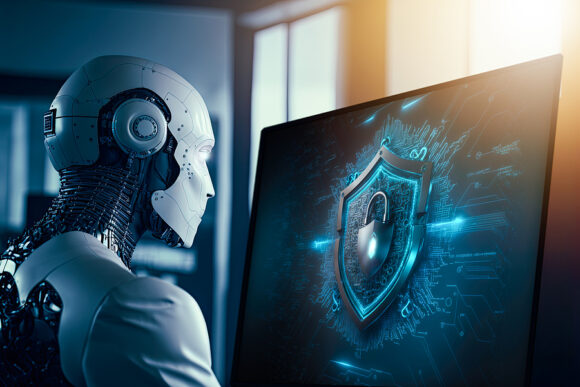Nationwide’s Chetan Kandhari said the company is working to build a bionic workforce.
Maybe that brings to mind robots, futuristic technology and sci-fi imagery, but Kandhari said no one should fear robots replacing humans. Bionic simply means that biological components are aided by technology or electronics, and he said this balance is key in driving the workforce at Nationwide forward with generative AI technology assisting human workers.
“One of the things that we think about in the notion of bionic is this augmented play between people and machines, and that’s where the bionic word comes in,” he said during Carrier Management’s annual InsurTech Summit, held May 21. “It’s how do you really commingle the two in a way to give excellent customer experience.”
Kandhari is the chief innovation and digital officer at Nationwide, where he’s responsible for leading the company’s digital vision while creating new customer-focused products and services for members and partners. He said this work has been accelerated by the use of generative AI.

“What we can do with the bionic piece is combine and augment the intelligence of the human being with the human in the loop, along with this capability from the machines and with generative AI,” he said.
Nationwide does this in multiple ways through front-office and back-office functions, he explained. He said generative AI is helpful for front-office functions such as customer service, conversations between wholesalers and advisers, internal sales and distribution, as well as back-office tasks such as human resources, legal considerations, risk management or IT coding. He said the company is even testing internal chatbots to assist staff members who seek additional training or are looking for quick resources.
Kandhari sees all of this contributing to a transformed relationship between insurers and their customers as humans and AI robots work together to “demystify” insurance, making it simpler and more efficient.
“If you think about it right now, how many people really understand insurance?” he said. “How much jargon is there in the insurance vernacular? So, imagine if you could just convert that into straightforward English for everybody to understand. Demystify it. Demystify these contracts that we have. I think the relationship between insureds—the protected and the protector—will become a lot easier. And I think people will understand the value of these products in a way that’s better today.”
This, in turn, will bring more trust to an industry that has struggled to win the trust of its consumers Kandhari continued.
“I think that will bring more trust to this industry which we know often is not as trusted,” he said. “We might over time be able to be more competitive in our pricing of these products and that, ultimately, is I think better. It drives more economic value to the consumer.”
Challenges Ahead
However, the road there will likely be paved with challenges.
“We have a lot of challenges,” he said. “We have challenges relative to bias and responsible AI. We have challenges for people believing in whether technology is giving the accurate information. We also have challenges with how do you fit this into your business process. I think getting the data right, getting the bias out of our models, is going to be work cut out for us.”
He said Nationwide has worked to get on top of this by hiring a team of experts to ensure information from its generative AI models is accurate.
“We deployed it to experts first who said whether the generation was correct or not correct,” he said. “And over time, we would get feedback into the system.”
One of the biggest challenges insurers will need to navigate when it comes to generative AI, Kandhari said, is fear.
“There has been fear of many technologies that have been rolled out over decades and centuries. If you take a step back, there was a fear, when the personal computer came out, of job losses,” he said. “But if we take a step back and think about what it’s really done to society, it’s really ramped up productivity…The technology age has ramped up productivity like nothing before, and I believe generative AI is going to be just like that.”
That said, Kandhari believes this technology will change how the industry looks and lead to a needed skills refresh as the type of work available to humans shifts.
“I think it will, as always, lead the human population to higher-value, creative, empathic, decision-making type of work as opposed to rapid tasks,” he said.
To tackle this challenge, Nationwide has employed a red team, blue team approach.
“One of the things that we do as a blue team is really thinking about opportunities and how to drive forward,” he said, while the red team is focused on challenges and risks that could come from those opportunities.
“So, the two of them really work together,” he said. “And the other thing that we have within those two teams is our HR processes and our people. So, one thing we’re trying to understand is do we need new skill sets to really work with the machines and the human beings? Do we need people who understand the concept of prompt engineering?”
Advice to Business Leaders
He encouraged other company leaders to ensure they’re implementing generative AI within the context of a real business problem that human workers couldn’t have solved as efficiently on their own. He also said business leaders need to understand that it’s going to be a journey.
“To put something up quickly is easy. But to put something up quickly, accurately and at scale requires a lot of work, and it requires intentionality in all of your business processes, your experience, design, the augmented intelligence, all of those components,” he said. “I would say get yourself some momentum with two or three use cases. Don’t try to boil the ocean.”
He added that leaders implementing generative AI within their business strategy should also stay true to their principles and create a goal for their organization that they can return to again and again.
“And then probably, finally, make sure you’ve got good checkpoints,” he said, “to know that the value is being obtained relative to these use cases.”
Ultimately, he said he believes the use of generative AI to build a bionic workforce will work best when humans are kept in the loop.
“Empathy cannot be replaced. Human beings give more confidence when people are at a loss,” he said. “The decision is still in the hands of the human.”
The full conversation is available for a limited time for free on demand at www.theinsurtechsummit.com.
Was this article valuable?
Here are more articles you may enjoy.



 US Home Insurance Still Priced Too Low for Climate Risk, Says Swiss Re Chair
US Home Insurance Still Priced Too Low for Climate Risk, Says Swiss Re Chair  As Rates Rise, Majority of Homeowners Say Insurance Industry Is in Crisis: Survey
As Rates Rise, Majority of Homeowners Say Insurance Industry Is in Crisis: Survey  ‘Great Resignation’ Enters Third Year as Workers Embrace AI, Upskilling, PwC Says
‘Great Resignation’ Enters Third Year as Workers Embrace AI, Upskilling, PwC Says  Changes at American Coastal Insurance After Florida OIR Action on ‘No-Fly List’
Changes at American Coastal Insurance After Florida OIR Action on ‘No-Fly List’ 


